1/72nd Trumpeter N. American RA-5C Vigilante,USN
This is my first first attempt at building a Trumpeter kit and I chose a good one. This project started back in 2012 for the ARC 100th Anniversary USN Group Build. It was one of several projects that was started for that GB, this representing the USN during the Cold War period. This was the only project in the GB that didn't get finished. So I dabbled on it off and on for the last 2 years until finally finishing it this weekend.
The A-5A Vigilante was first developed as a nuclear strike capable aircraft for the USN as part of the nuclear triad. To replace the Skywarrior ironically. This role was very short. First flight took place in August 1958. A requirement that was first proposed in 1953 for a supersonic carrier borne aircraft capable of delivering nuclear weapons. At the time the largest and most complicated aircraft to operate off the carrier. Powered by 2 GE J-79 turbojet engines, the same engines that powered the F-4 Phantom. The unusual bomb bay design was internal and located between the engines. The tail cone would eject to allow the weapons to slide back and drop away from behind the aircraft.
http://commons.wikimedia.org/wiki/File:A.5internalbay.png
The Vigilante had a crew of 2, pilot, BN and later the RAN,recon/attack navigator. The called a "heavy" when clean the RA-5 was quite agile and fast, fighters had a hard time to keep up with it. Which also made it extremely difficult to trap for inexperienced and unwary pilots when landing. The A-5B added an extra set of hard points on the wings, internal fuel tanks were added which gave it the distinctive hump in the dorsal area of the fuselage.
The Reconnaissance version, increased wing area, and the recon canoe pallet under the fuselage to house the cameras,sensors and equipment. The RA-5C retained the AN/ASB-12 bombing system that in theory it was still able to carry weapons although it never did in service. The Vigilante served on until it's retirement in 1979 with RVAH-7, out of NAS Key West.
The Trumpeter kit is like a 48th scale kit shrunk down to 72nd scale. It's not like the old Revell or Hasegawa kits which are still decent but not as complicated. Lot's of parts in this kit. I used Eduards zoom set to enhance a pretty detail cockpit which is actually pretty good as it it is. This is one cockpit that deserves to be viewed with the canopies open. Despite the amount of parts it really goes together quite well. The parts call out and process is pretty good. The nose gear design has it installed before the fuselage halves are cemented together, don't really care about that too much as it leads to a chance of breaking, though it is quite sturdy. Seam work on the tail cone to tail around exhaust cones really needs a lot of cleanup. The canoe hides the center seam when that gets installed. Engraved panel lines may be a little deep but some may not like that but it is what it is. Using Floquil Reefer White for the under surfaces and flaps and tail. Aeromaster Lt Gull Grey for the upper surfaces. MM steel for exhaust cones, Alclad Steel for the tail cone. The markings are Superscale Decals for RVAH-14, flying off the USS Independence (CV-62) in 1973. Now I can recall why I didn't finish the Vigilante in time was I couldn't find any decals other than what the kit provided. No problem finding AM decals in 48th scale, heck of a time finding a set in 72nd scale. Overall a fun challenging kit to build. This Vigilante is large. Even larger than the F-105 in 72nd scale. Looks great parked next to the F-8 and Skyraider which it shared a flight deck at one time. Thanks for viewing.
Chuck
Fly Navy
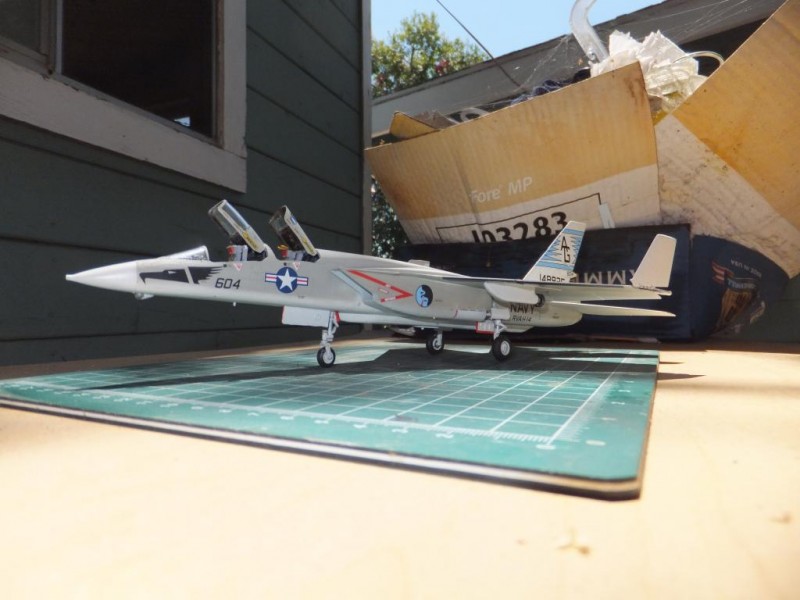
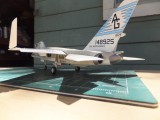
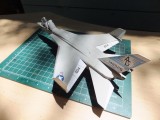
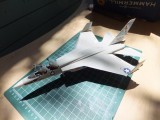
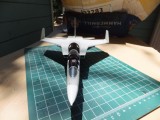
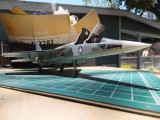
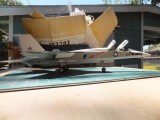
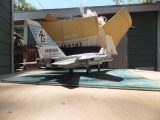
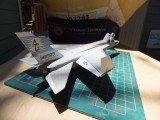

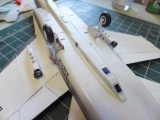
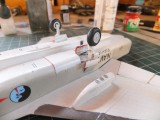
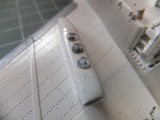
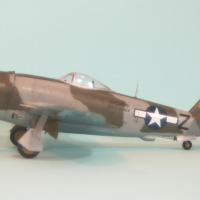
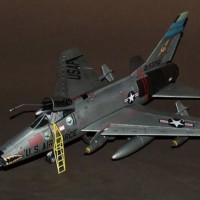
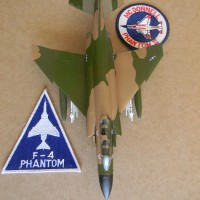
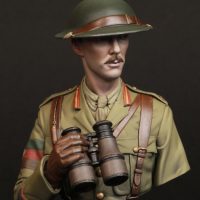
Well done, very interesting model and aircraft. Whew! What a beast it was! looks like the folding wingtips were a nice try, as it looks to be about 60Ft long! The fuselage probably neededed to fold in half to get that down below! Must have stayed topside. Are those air to air re-fueling shuttlecocks on those wing housings? What a huge aircraft to fly off a carrier. Like the F15 style intakes and that huge swept vertical fin.
Thanks James, it was huge, the nose folded and the tail was folded in half to clear the upper the deck when in the hanger. But on the flight deck when it was configured for flight it was graceful in appearance.
A very nice, sharp looking bird. Love this high - viz schemes. well done
Bernd
Thank you Bernd appreciate the comments.
Nice one Chuck.
Rather futuristic before its time.
Well done Chuck.
It was Simon and remember being late 50's and 60's technology it also had the very first fly by wire flight control system. Though primitive compared to what the F-16 would have 15 years later.
Glad to see a finished example of this kit. Another one that sits on my unfinished shelf.
Yours is exceptional.
Thanks Al, it is pretty detailed when you first pop the lid and look at the sprues with all kinds of detail bits and pieces. The box it comes in is large, yet a Hase and Revell Vigilante when built are the same size, the boxes are much smaller. Trumpeter is really over engineered, it takes 5 pieces to make up the main wheels each for a total of ten. I can imagine how detailed the 48th kit it.
beautiful job on a gorgeous aircraft
Thanks Bob, the Vigilante is a beautiful plane. Graceful lines when in flight. One of those planes that served with distinction but no fan fare. With Phantoms, Corsairs and Skyhawks and even Skyraiders getting the attention.
A very nice build indeed, Chuck...but - you really must take into consideration your background when photographing your work. The viewer's eye(s) are drawn away from the subject matter when there are distracting items more prominent than your model. A few simple pieces of poster board would do the trick...or even placing the model on a sidewalk or driveway, just so the model is the only thing in the shot. It'll make a big difference, believe me.
I'm certainly not try to be critical here, Chuck, simply trying to point out that the photos are sharp, clear and well lit...but cluttered with various other objects. When you've done such a great job completing a fantastic build, it's a shame to see it posed in front of a box of garbage. I hope you accept my suggestions in the manner in which they were offered.
Thanks for the pointers Craig, but I'm just the type that don't like doing a studio setting. Just my choice. The first thought that came to mine though was the box in the background that is a distraction. But what the heck went with it anyway. I am an on the fly type photographer, not a studio setting type with lights, reflectors and what have you. Always with a camera on me when something catches my fancy out comes the camera for a quick shot and what ever the lens sees it gets it. Just me. And that is not a box of garbage. That is a box of some of my Navy stuff that the weather is a non factor. No offense taken by the way. It's all good.
Not a problem, Chuck...to each his own I always say. I don't do the "studio setting" photography either.. I sometimes just set it outdoors somewhere or throw up a couple of backboards on the workbench and be done with it. I do envy, however, those modelers who have the talent to get a beautiful shot without any shadows whatsoever. Happy modeling, sir.
Nice clean build of the "golden age"(1950's) of carrier aircraft. I thought the cardboard in the background was a scale jet blast deflector plate, barrier or what ever...
Yes Mike those first generation of carrier borne jets were quite unique and a time when all kinds were being introduced and then withdrawn. Growing pains. Fly Navy
All I remember about the 1/48 Trumpeter kit was that when I discovered that the separate leading edge slats were thicker than the wing they were to attach to, on top of all the other boo-boos, I took out out to the trash, stomped it into its component plastic atoms, and dumped it.
Apparently they learned their lesson with the 1/72 kit. Yours certainly looks nice.
Thanks Tom, you know I have never seen the 48th kit, though I have read several build articles, it is quite labor intensive, with all of the corrections and extra bits you have to get for it to build it. The 1 piece that got me is an insert you really need to keep the fuselage from coming apart at the seams. Expensive and more expensive AM bits to build that kit. But I tell ya when finished it is quite impressive and a lot of patience.
Chuck,
I was never really a fan of this airplane but I think you may have convinced me that it is indeed beautiful. As for the photo background, just tell everyone that sailors on the mess deck has the garbage ready to go over the side.
Frank I feel the same way, did build the Revell one as a kid, only because it came in the mail as part of the model of the month club that Revell used to do when I was growing up. So I built it. Otherwise I liked planes with all kinds of ordnance, guns or whatever I can hang. But like anything else as you get older,wiser, you start to appreciate all the things that at one time you wouldn't give a second thought to. Like Classical music, Fine Arts, (though I did start really getting interested in the Arts after a field trip to the Huntington Gallery in 6th grade, what a great museum that is) and recon type aircraft and how important they were in their missions.
I'm no expert on US Naval aircraft (or any aircraft, come to that), but I know what I like, and I like this one a lot, it's a very impressive model, beautifully built and finished.